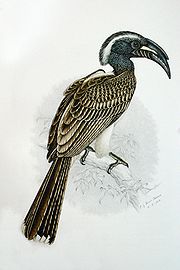
African Grey Hornbill
Encyclopedia

Hornbill
Hornbills are a family of bird found in tropical and subtropical Africa, Asia and Melanesia. They are characterized by a long, down-curved bill which is frequently brightly-colored and sometimes has a casque on the upper mandible. Both the common English and the scientific name of the family...
. Hornbills are a family of tropical near-passerine bird
Bird
Birds are feathered, winged, bipedal, endothermic , egg-laying, vertebrate animals. Around 10,000 living species and 188 families makes them the most speciose class of tetrapod vertebrates. They inhabit ecosystems across the globe, from the Arctic to the Antarctic. Extant birds range in size from...
s found in the Old World
Old World
The Old World consists of those parts of the world known to classical antiquity and the European Middle Ages. It is used in the context of, and contrast with, the "New World" ....
.
The African Grey Hornbill is a widespread and common resident breeder in much of sub-Sahara
Sahara
The Sahara is the world's second largest desert, after Antarctica. At over , it covers most of Northern Africa, making it almost as large as Europe or the United States. The Sahara stretches from the Red Sea, including parts of the Mediterranean coasts, to the outskirts of the Atlantic Ocean...
n Africa
Africa
Africa is the world's second largest and second most populous continent, after Asia. At about 30.2 million km² including adjacent islands, it covers 6% of the Earth's total surface area and 20.4% of the total land area...
and into Arabia
Arabian Peninsula
The Arabian Peninsula is a land mass situated north-east of Africa. Also known as Arabia or the Arabian subcontinent, it is the world's largest peninsula and covers 3,237,500 km2...
.
This is a bird mainly of open woodland and savannah. The female lays two to four white eggs in a tree hollow
Tree hollow
A tree hollow or tree hole is a semi-enclosed cavity which has naturally formed in the trunk or branch of a tree. These are predominantly found in old trees, whether living or not...
, which is blocked off during incubation with a cement made of mud, droppings and fruit pulp. There is only one narrow aperture, just big enough for the male to transfer food to the mother and the chicks.
When the chicks and the female are too big to fit in the nest, the mother breaks out and rebuilds the wall, then both parents feed the chicks.
This species is a large bird, at 45cm in length, but is one of the smaller hornbills. It has mainly grey plumage, with the head, flight feathers and long tail being a darker shade. There is a white line down each side of the head and one on the back which is visible only in flight. The long curved bill is black and has a small casque and a creamy horizontal stripe.
The male has a black bill, whereas the female has red on the mandibles. The plumage of the male and female is similar. Immature birds are more uniformly grey. The flight is undulating. The similarly sized Red-billed Hornbill
Red-billed Hornbill
Red-billed Hornbill is a relatively small species of hornbill found in savanna and woodland of sub-Saharan Africa. It is sometimes split into five species, the Northern Red-billed Hornbill , Western Red-billed Hornbill , Tanzania Red-billed Hornbill , Southern Red-billed Hornbill Red-billed...
has uniformly grey plumage.
The African Grey Hornbill is omnivorous, taking insects, fruit and reptiles. It feeds mainly in trees.
This conspicuous bird advertises its presence with its piping pee-o pee-o pee-o call.

